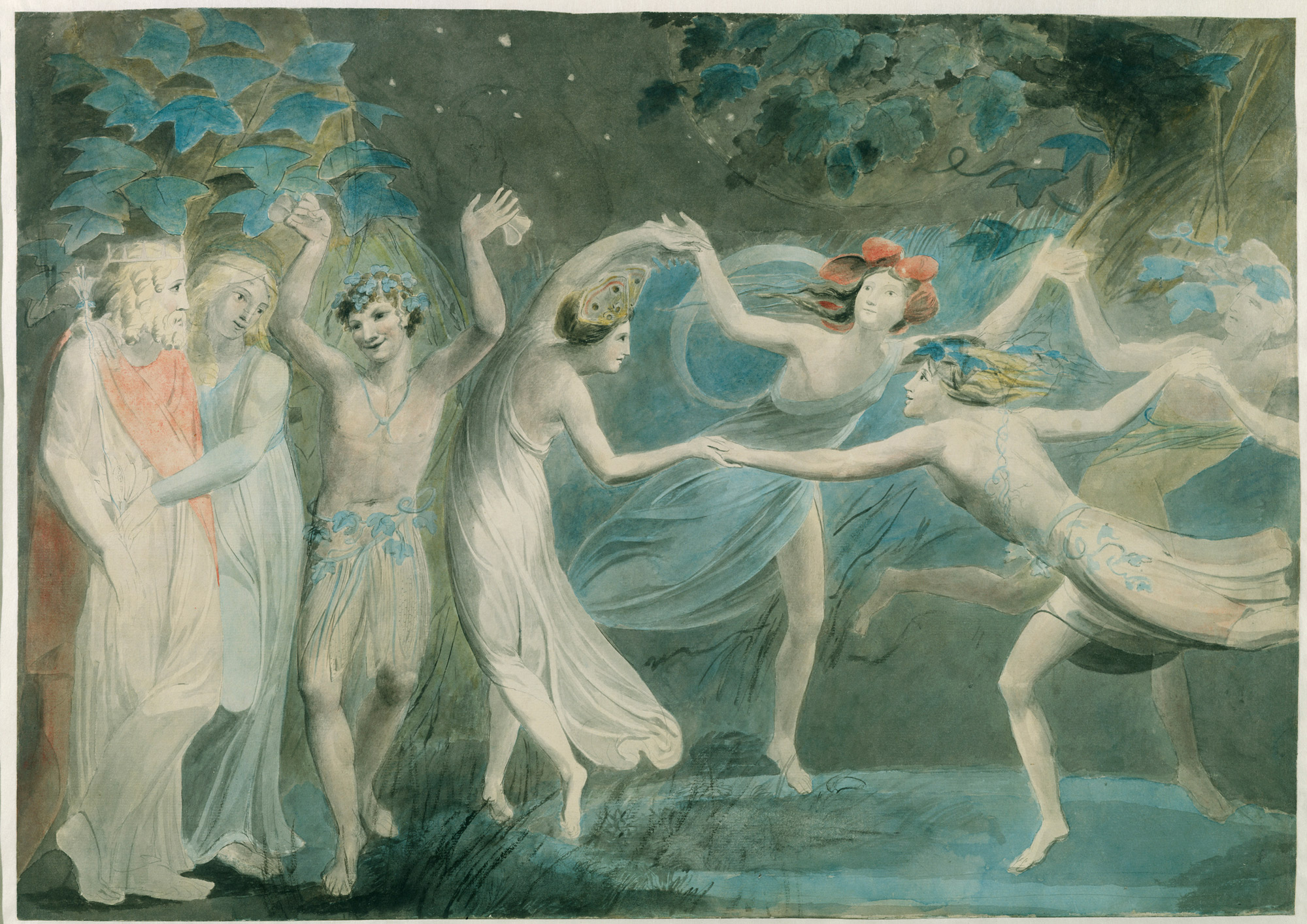A mature Blake must have loved Shakespeare about as much as Milton or the Bible.
Oberon, Titania and Puck with Fairies dancing
Oberon, Titania and Puck with Fairies Dancing
wikipedia Commons |
Blake let his imagination roam widely as had Shakespeare before him. They both wrote about fairies as if they had a first hand acquaintance. In Midsummer Night's Dream Shakespeare takes us into the world which awakes while we sleep and dream, ruled by the king and queen of fairies. Blake pictured a joyful image of fairies dancing before their king and queen with Puck who was given the power to alter how individuals perceived one another.
Blake pictured the same pair, Oberon and Titania, on Plate 5 of Song of Los resting comfortably within two adjacent lilies. Titania sleeps while Oberon holds a sceptre.
In his Descriptive Catalogue, Blake introduces the idea that in Shakespeare and Chaucer fairies are rulers of the vegetable world, perhaps indicating that he uses them in the same way.
Descriptive Catalogue, (E 535)
"By way of illustration, I instance Shakspeare's Witches in Macbeth. Those who dress them for the stage, consider them as wretched old women, and not as Shakspeare intended, the Goddesses of Destiny;
This shews how Chaucer has been misunderstood in his sublime work. Shakspeare's Fairies also are the rulers of the vegetable world, and so are Chaucer's; let them be so considered, and then the poet will be understood, and not else."
Letter 44 (Erdman 749) to Hayley:
Blake is telling Hayley what he had done about Flaxman's Homer:
"the price I received for engraving Flaxman's outlines of Homer
is five guineas each."
(The relationships among these three men (Blake, Flaxman, and Hayley is interesting and significant.)
In an Island in the Moon; (E455):
"I think that Homer is bombast & Shakespeare is too wild"
We may find quotations from Shakespeare and allusions to Shakespeare scattered through his works, some obvious and others less so.
In Annotations to Swedenborgs Heaven and Hell he commented disparagingly about a reference he had made to Shakespeare. (Erdman 601)
In Prospectus (E692) he referred to the inability of Milton and Shakespeare to publish their own works.
In letters 32, 36, and 46 (and others):
Fuseli was a friend and fellow artist of Blake's. After Blake had returned from Felpham (and the patronage of Hayley) he was involved in the Shakespeare plates of Fuseli.
Writing to William Hayley (Erdman 742):
"I cannot omit observing that the price Mr. Johnson gives for the plates of Fuseli's Shakespeare (the concluding numbers of which I now send) is twenty-five guineas each."
"I cannot omit observing that the price Mr. Johnson gives for the plates of Fuseli's Shakespeare (the concluding numbers of which I now send) is twenty-five guineas each."
He told Hayley that he had enclosed "the Numbers of Fuseli's Shakespeare that are out". (Letter 36 Erdman 742)
This quotation places Milton and Shakespeare together as did the letter to Flaxman; in Public Address :
"The Originality of this Production makes it necessary to say a few words While the Works [of Translators] of Pope & Dryden are lookd upon as [in the Same class of] the Same Art with those of Milton & Shakespeare.
.............
Drawn with a firm hand at once [with all its Spots & Blemishes which are beauties & not faults] like Fuseli & Michael Angelo Shakespeare & Milton;"
(Erdman 576)
In Blake's Descriptions to Illustrations to Milton's L'Allegro he offered us
"Or Sweetest Shakespeare Fancys Child",
presumably a quotation to Milton, to which Blake added:
"The youthful Poet sleeping on a bank by the Haunted Stream by Sun Set sees in his Dream the more bright Sun of Imagination. under the auspices of Shakespeare & Johnson. in which is Hymen at a Marriage & the Antique Pageantry attending it"
This appears in a recent post, which I've copied bodily:
Saturday, September 22, 2012
MILTON'S L'ALLEGRO VI
In his manuscript notes accompanying his watercolors Blake singles out these verses from Milton for his sixth illustration to L'Allegro:
Descriptions of Illustrations to Milton's L'Allegro and Il Penseroso (E 682)
"There let Hymen oft appear In Saffron Robe with Taper clear With Mask & Antique Pageantry Such sights as Youthful Poets dream On Summers Eve by haunted Stream Then lo the well trod Stage anon If Johnsons learned Sock be on Or Sweetest Shakespeare Fancys Child Warble his native wood notes wild"
Blake wrote:
"The youthful Poet sleeping on a bank by the Haunted Stream by Sun Set sees in his Dream the more bright Sun of Imagination. under the auspices of Shakespeare & Johnson. in which is Hymen at a Marriage & the Antique Pageantry attending it"
The youthful poet had entered a dream state which offered a pleasant interlude from the cares of the world. He visited with some of the sources of his inspiration: Shakespeare & Johnson are adjacent to the great sun but not within it.


No comments:
Post a Comment